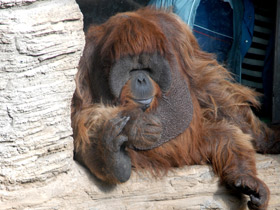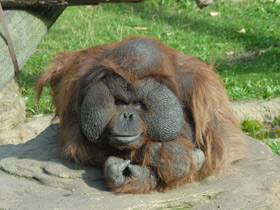Orangutans (the genus Pongo)
Orangutans are great apes native to the rainforests of Indonesia and Malaysia. They are now found only in parts of Borneo and Sumatra, but during the Pleistocene they ranged throughout Southeast Asia and South China. Classified in the genus Pongo, orangutans were originally considered to be one species. From 1996, they were divided into two species: the Bornean orangutan (P. pygmaeus, with three subspecies) and the Sumatran orangutan (P. abelii). A third species, the Tapanuli orangutan (P. tapanuliensis), was identified definitively in 2017. The orangutans are the only surviving species of the subfamily Ponginae, which diverged genetically from the other hominids (gorillas, chimpanzees, and humans) between 19.3 and 15.7 million years ago.
Description
Orangutans are one of the largest orangutan monkeys (male orangutans can weigh up to 100 kg, have a body length of 150 cm and an arm span of 2.25 m). Females are considerably smaller, weighing only 40-50 kg. Orangutans have a rather awkward build: the forelimbs are very elongated, the legs are relatively short and the abdomen is large. Their hands and feet are well adapted for life in trees: 4 fingers grasp branches like a powerful hook. Orangutan brains are large, measuring between 300 and 500 cc, and their structure is very similar to that of humans.
Lifestyle
Orangutans live in forests and are mainly arboreal. In trees, they walk rather than "fly", as gibbons do, and usually move slowly and carefully, making sure to test the resistance of branches and not tearing off an arm or leg until they are firmly grasped by other limbs. In a day, orangutans move only 300-800 metres and very rarely walk more than 1 km. Adult males, sufficiently protected from enemies by their size, usually descend to the ground. To spend the night, orangutans build a nest or a platform of branches in trees. They live alone, in pairs or in small groups, usually in families (most often females with cubs of different ages). Adult males live separately and have large territories overlapping those of several females, which they visit from time to time.
Nutrition
Orangutans feed mainly on fruits (especially durian), leaves, seeds, shoots, bark, insects, insects, chicks and bird eggs. They drink water from tree depressions and lick it from their fur and leaves. The highly developed intelligence of orang-utans is demonstrated by the fact that in the wild they often use and can even make some tools: for example, sticks for picking fruit, chewing twigs and using the sponge thus obtained to collect water from holes and cavities. Orangutans are well aware of all the peculiarities of their patches; for example, they know exactly where all the fruit trees are located and which one is bearing fruit at any given time.
Reproduction
Like humans, female orang-utans have one offspring for 9 months. There is usually one offspring per litter, twins are very rare. The calf is born in its mother's nest, sometimes cared for by her eldest daughter. The newborn weighs about 1.5 kg. The calf does not begin to move away from its mother until it is six months old; until then, it is in direct physical contact with its mother almost continuously. Females usually continue to nurse their young until they are 3-4 years old, but young orangutans do not become fully independent even after that. Great apes have the longest infancy period in the animal world, and until 6-8 years of age young orangutans tend to stay with their mothers and continue to learn all the tricks of life from them. They will almost certainly die if left alone for any reason; unfortunately, this is not uncommon due to the numerous poachers.
In the course of their lives, female orangutans give birth to and raise only 4 or 5 cubs, and that's at best! This low reproduction rate has undoubtedly played a role in the fact that these great apes are now on the verge of extinction.
Habitat
Orangutans are only found on two small islands in Southeast Asia: Sumatra and Kalimantan, and each island is home to a different subspecies. Zoologists have recently elevated them to species status, so that there are now two species: Pongo abelii and Pongo pygmaeus.
Populations of these great apes have declined considerably in recent times, with about a thousand remaining in Sumatra and about 2,000 in Kalimantan, and the species is listed on the IUCN Red List.
The only way to save the orang-utans in the face of diminishing forest cover is to establish nature reserves. In addition, several orangutan rehabilitation centres have been set up in Sumatra and Kalimantan: they raise orphaned cubs and illegally captured animals, train them in the wild and release them.
Phylogeny and genetics
The three orangutan species are the only living members of the subfamily Ponginae. This subfamily also includes the extinct genera Lufengpithecus, which lived in southern China and Thailand between two and eight million years ago, and Sivapithecus, which lived in present-day India and Pakistan between 12.5 and 8.5 million years ago. These apes probably lived in drier and colder environments than their living relatives. The species Khoratpithecus piriyai, which lived in Thailand between seven and five million years ago, is believed to be the closest to today's orangutans. The largest known primate, the extinct Gigantopithecus, is also a member of Ponginae and lived in China, India and Vietnam between 5 million and 100,000 years ago. Within the superfamily Hominoidea, gibbons diverged in the early Miocene (between 19.7 and 24.1 million years ago, according to molecular evidence) and orangutans diverged from the other great apes of Africa between 15.7 and 12.3 million years ago. The Bornean and Sumatran orangutans diverged 400,000 years ago, according to a recent genetic study.
Today's orangutans are as follows:
Pongo pygmaeus, Bornean orangutan, with three subspecies:
- Pongo pygmaeus pygmaeus pygmaeus;
- Pongo pygmaeus morio;
- Pongo pygmaeus wurmbii;
- Pongo abelii, Sumatran orang-utan;
- Pongo tapanuliensis, Batang Toru orang-utan.

















































